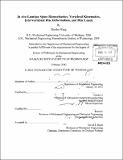In vivo lumbar spine biomechanics : vertebral kinematics, intervertebral disc deformation, and disc loads
Author(s)
Wang, Shaobai
DownloadFull printable version (27.82Mb)
Other Contributors
Massachusetts Institute of Technology. Dept. of Mechanical Engineering.
Advisor
Guoan Li.
Terms of use
Metadata
Show full item recordAbstract
Knowledge of lumbar spine biomechanics in living human subjects is fundamental for understanding mechanisms of spinal injury and pathology, for improvement of corresponding clinical treatments, and for design of spinal prosthesis. However, due to the complicated spine anatomy and loading conditions as well as high risks in these direct measurements, it has been a challenge to determine the in vivo biomechanics of the lumbar spine. To address this problem, the overall objective of this thesis was to develop and implement a dual fluoroscopic imaging system to non-invasively study human lumbar spine biomechanics. In line with this objective, the first goal was to quantify the ability of the dual fluoroscopic imaging system to determine vertebral kinematics. The second goal was to implement this technique to investigate spinal motion in both healthy subjects and patients with pathology. The third goal was to explore the feasibility of using kinematic data obtained from this system as boundary conditions in finite element analysis to calculate the physiological loads on the intervertebral disc. The system was shown to be accurate and repeatable in determining the vertebral kinematics in all degrees of freedom. For the first time, six degree-of-freedom motion of different structures of the spine, such as the vertebral body, intervertebral disc, facet joint and spinous process were measured in vivo in both healthy subjects and subjects with pathology during functional activities. In general, the group of subjects with pathology showed a significantly abnormal kinematic response during various physiological functional activities. Preliminary studies have shown the applicability and high accuracy of finite element modeling to calculate disc loads using in vivo vertebral kinematics as displacement boundary conditions.
Description
Thesis (Ph. D.)--Massachusetts Institute of Technology, Dept. of Mechanical Engineering, 2012. Cataloged from PDF version of thesis. Includes bibliographical references.
Date issued
2012Department
Massachusetts Institute of Technology. Department of Mechanical EngineeringPublisher
Massachusetts Institute of Technology
Keywords
Mechanical Engineering.